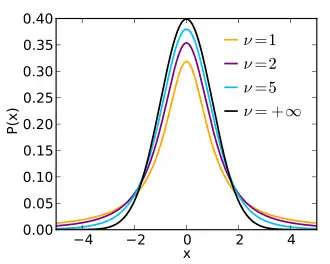Student-t Distribution
Student’s t
Probability density function

|
Cumulative distribution function

|
| Parameters
|
ν > 0 degrees of freedom (real)
|
| Support
|
x ∈ (−∞; +∞)
|
| PDF
|

|
| CDF
|
![{\displaystyle {\begin{matrix}{\frac {1}{2}}+x\Gamma \left({\frac {\nu +1}{2}}\right)\cdot \\[0.5em]{\frac {\,_{2}F_{1}\left({\frac {1}{2}},{\frac {\nu +1}{2}};{\frac {3}{2}};-{\frac {x^{2}}{\nu }}\right)}{{\sqrt {\pi \nu }}\,\Gamma \left({\frac {\nu }{2}}\right)}}\end{matrix}}}](../../_assets_/eb734a37dd21ce173a46342d1cc64c92/02732e546784af1fb16d0dc1bb65dd743e2284ad.svg)
where 2F1 is the hypergeometric function
|
| Mean
|
0 for ν > 1, otherwise undefined
|
| Median
|
0
|
| Mode
|
0
|
| Variance
|
 for ν > 2, ∞ for 1 < ν ≤ 2, otherwise undefined for ν > 2, ∞ for 1 < ν ≤ 2, otherwise undefined
|
| Skewness
|
0 for ν > 3, otherwise undefined
|
| Ex. kurtosis
|
 for ν > 4, ∞ for 2 < ν ≤ 4, otherwise undefined for ν > 4, ∞ for 2 < ν ≤ 4, otherwise undefined
|
| Entropy
|
...
|
| MGF
|
undefined
|
| CF
|
 for ν > 0 for ν > 0
 (x): Bessel function[1] (x): Bessel function[1]
|
Student t-distribution (or just t-distribution for short) is derived from the chi-square and normal distributions. We divide the standard normally distributed value of one variable over the root of a chi-square value over its r degrees of freedom. Mathematically, this appears as:

where  and
and  .
.
External links
- ↑ Hurst, Simon, The Characteristic Function of the Student-t Distribution, Financial Mathematics Research Report No. FMRR006-95, Statistics Research Report No. SRR044-95

